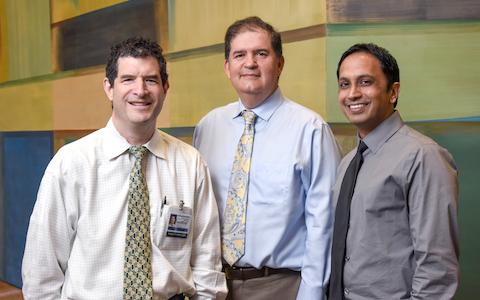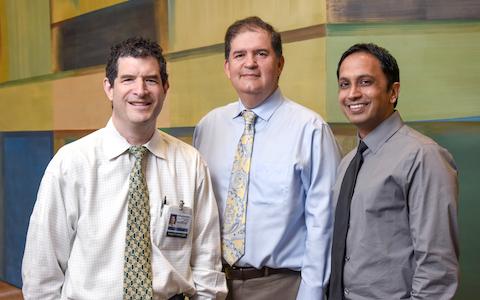
Credit: UT Southwestern
DALLAS – November 18, 2016 – Proactive outreach to cirrhosis patients in a safety net health system successfully doubled their screening rates for liver cancer, UT Southwestern Medical Center researchers found.
Cirrhosis (liver disease) patients are at high risk to develop liver cancer, which is increasing in frequency an average of 3 percent annually and has a five-year overall survival rate of just 17.5 percent.
"Finding ways to reach patients at high risk of liver cancer is critical. Liver cancer has the fastest increasing mortality rate among solid tumors in the U.S.," said first author Dr. Amit G. Singal, Associate Professor of Internal Medicine and Clinical Sciences, and a member of the Harold C. Simmons Comprehensive Cancer Center. "This high mortality is primarily due to low rates of liver cancer screening and high rates of late-stage diagnosis."
The study randomly divided 1,800 cirrhosis patients at Parkland Health & Hospital System in Dallas into three groups. The first group received mailed outreach invitations for screening ultrasound. The second group received similar outreach plus patient navigation, and the third received their usual care. Researchers learned that the group receiving mailed outreach invitations were most likely to schedule an ultrasound, which doubled the overall rate of screening.
The study appears in the journal Gastroenterology.
"Our study is one of the first interventions to improve liver cancer screening and early detection among at-risk patients. The vulnerable patient population we studied in our safety net health system are those who are at highest risk of dying from liver cancer, so this intervention helped those who might benefit the most," said Dr. Singal.
Only one-fourth of patients with cirrhosis in routine care are currently screened every six months for liver cancer with an ultrasound as recommended by national guidelines. Symptoms are not usually present when the cancer is in its early stages.
"Our research previously demonstrated that liver cancer screening is underused in clinical practice, with lower rates of screening among racial/ethnic minorities and socioeconomically disadvantaged patients," said senior author Dr. Ethan Halm, Director of the Center for Patient-Centered Outcomes Research, Chief of the William T. and Gay F. Solomon Division of General Internal Medicine, and Professor of Internal Medicine and Clinical Sciences. "Our new study presents a model of a proactive, population health outreach strategy that can improve liver cancer screening and early detection among those at highest risk of adverse outcomes." Dr. Halm holds the Walter Family Distinguished Chair in Internal Medicine in Honor of Albert D. Roberts, M.D.
According to the National Cancer Institute, liver cancer is diagnosed in an estimated 39,230 people annually. In 2013, there were an estimated 54,954 people living with this cancer in the U.S. Risk factors include a diagnosis of fatty liver disease, hepatitis B, hepatitis C, cirrhosis, or a combination of these diseases.
###
Additional UT Southwestern faculty who contributed to the study include: Dr. Jasmin A. Tiro, Associate Professor of Clinical Science and member of the Simmons Cancer Center; and Dr. Jorge A. Marrero, Medical Director of Liver Transplantation, Associate Vice President, Clinical Transformation Officer, and Professor of Internal Medicine. Dr. Tiro, Dr. Marrero, Dr. Halm, and Dr. Singal are all members of the Simmons Cancer Center. Dr. Noel O. Santini from Parkland Health & Hospital System also contributed to the study.
This study was conducted as part of UT Southwestern's Center for Patient-Centered Outcomes Research with support from the Agency for Healthcare Research & Quality, the National Institutes of Health, and the National Cancer Institute. Dr. Singal reported being on the speaker bureau for Bayer Pharmaceutical and receiving grant funding from Gilead Pharmaceuticals.
The Harold C. Simmons Comprehensive Cancer Center is the only NCI-designated Comprehensive Cancer Center in North Texas and one of just 47 NCI-designated Comprehensive Cancer Centers in the nation. Simmons Cancer Center includes 13 major cancer care programs. In addition, the Center's education and training programs support and develop the next generation of cancer researchers and clinicians. Simmons Cancer Center is among only 30 U.S. cancer research centers to be designated by the NCI as a National Clinical Trials Network Lead Academic Participating Site.
What is Liver Cancer?
Cancer that starts in the liver is called primary liver cancer. There are often no symptoms for early-stage liver cancer. Liver cancer can also develop in the bile ducts within the liver.
Risk Factors for Liver Cancer
- Hepatitis B
- Hepatitis C
- Cirrhosis
- Fatty liver disease
Treatment Options
For primary liver cancer, treatment may include:
- Surgery
- Stereotactic radiation
- Chemotherapy
- Liver transplantation
- Local ablative therapies
- Clinical trials
Source: National Cancer Institute
About UT Southwestern Medical Center
UT Southwestern, one of the premier academic medical centers in the nation, integrates pioneering biomedical research with exceptional clinical care and education. The institution's faculty includes many distinguished members, including six who have been awarded Nobel Prizes since 1985. The faculty of almost 2,800 is responsible for groundbreaking medical advances and is committed to translating science-driven research quickly to new clinical treatments. UT Southwestern physicians provide medical care in about 80 specialties to more than 100,000 hospitalized patients and oversee approximately 2.2 million outpatient visits a year.
This news release is available on our website at http://www.utsouthwestern.edu/news.
To automatically receive news releases from UT Southwestern via email, subscribe at http://www.utsouthwestern.edu/receivenews.
Media Contact
Lori Sundeen Soderbergh
[email protected]
214-648-3404
@UTSWNews
http://www.swmed.edu
############
Story Source: Materials provided by Scienmag




